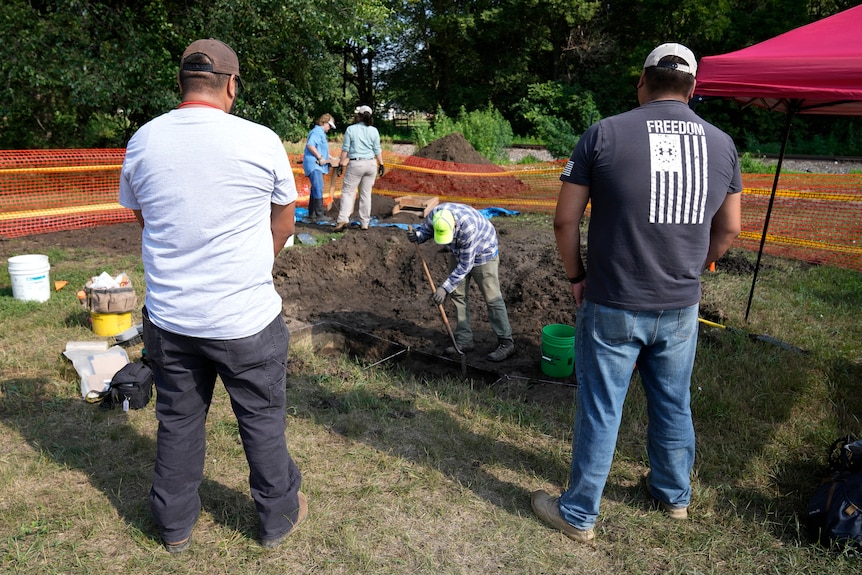A search for the remains of Native American children buried at the site of a former boarding school in the US state of Nebraska will continue next week after four days of searching failed to uncover any bones.
Key points:
- More than 1,000 unmarked graves were found at former schools in Canada in 2021
- It’s believed tens of thousands of Native American children could be buried at US boarding schools
- Excavation has begun at one of Nebraska’s former US Indian Industrial School
Archaeologists have been excavating the site of the US Indian Industrial School in the rural town of Genoa since Monday but have only managed to dig down to half of the depth required.
“We only got down four-and-a half-feet in the digging, we need to get to eight feet,” head of Nebraska’s Commission on Indian Affairs Judi gaiashkibos said.
“It’s so slow, every bit of dirt they have to sift through once they bring it up.
“It’s just very painstaking.”
Last year, the ABC’s Foreign Correspondent program filmed exclusively with the community as they began the harrowing search to locate the school’s long-lost cemetery and find out how many children died at the school.
The federally run school, which operated from 1884–1934 was one of America’s largest and longest-running institutions.
It was designed to assimilate Native American children by separating them from their families and tribes and breaking their culture and language.
“These were not schools. It was a prison camp, a work camp,” Ms gaiashkibos, whose mother attended the school, said.
“The children were used as labour. It wasn’t a lovely place to learn your education.”
She said the catalyst for the community’s investigations was the discovery in 2021 of more than 1,000 unmarked graves at the sites of former boarding schools across the border in Canada.
“When we first heard what was going on in Canada I said we’ve got to focus on the children that died here,” Ms gaiashkibos said.
“A cemetery at a school is not the norm — that you could die and then you’re gonna be buried out the door?”
Researchers and volunteers from the Genoa Indian School Digital Reconciliation project and the Genoa US Indian School Foundation scoured records to conclude that 86 children perished at the school.
While some of the children’s bodies were returned home, others were buried somewhere on the school’s 260-hectare campus.
This year, archaeologists discovered four anomalies — disturbances in the soil that could indicate a grave shaft.
An earlier search involving cadaver dogs also indicated the possible presence of human remains in the area.
Watching the excavation from the shade of a tree, surrounded by corn fields was Carolyn Fiscus, an enrolled member of the Winnebago tribe.
In 1927, her aunt Mildred was separated from her mother and sent nearly 200 kilometres by train to the institution in Genoa.
Three years later, at the age of 12, she died from influenza and meningitis.
Documentation states that Mildred’s body was returned to the Winnebago reservation, but Ms Fiscus says her tribe has no record of the burial.
“To lose a child, and then to lose them in that way, you don’t know what happened to them — it’s a very sad story for our family,” she said.
Ms Fisucs believes her aunt is one of the children buried in the school cemetery and is hopeful a discovery will be made soon.
“I was praying while I was out there … this has brought everyone together, we all want to know what happened and we want to finish this,” she said.
Ms Fiscus said if Mildred’s remains were recovered, she would like to bring her aunt home and conduct a proper ceremony.
“If by some miracle they identified Mildred, we would have a full wake and ceremony, even if it was only a few bones,” she said.
“We didn’t have that chance.”
A historic federal investigation into America’s boarding school era is currently underway.
With more than 300 federal and church run institutions across the country, the government estimates the number of children who died could be in the tens of thousands.
Ms gaiashkibos believes the number of children who died at boarding school in Genoa could be higher and is determined to bring justice to the children who “never made it home”.
“We say, in their final sleep, they woke a nation,” she said.
